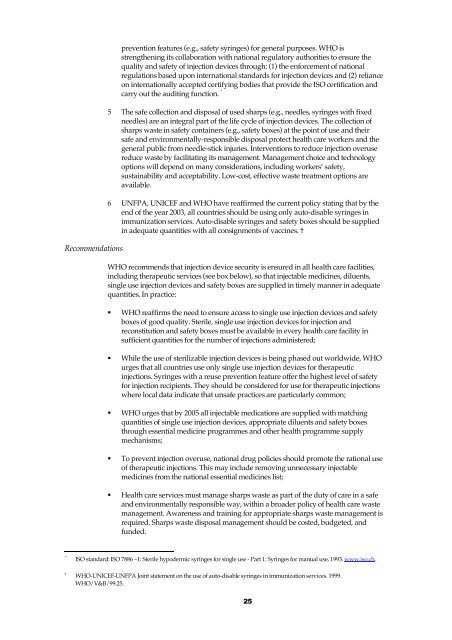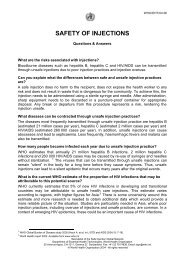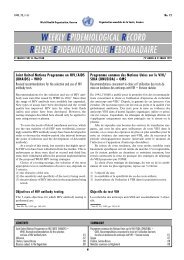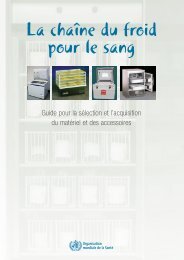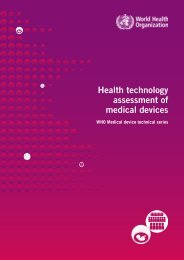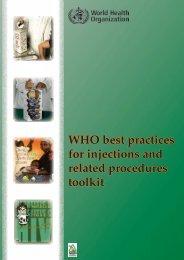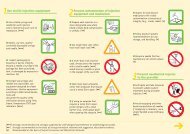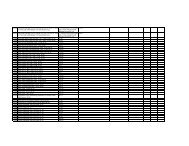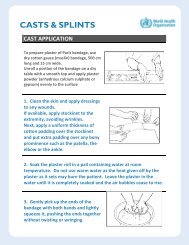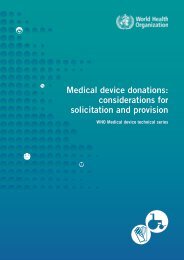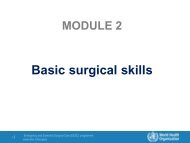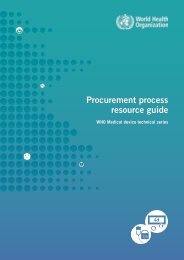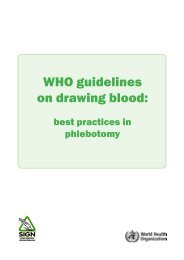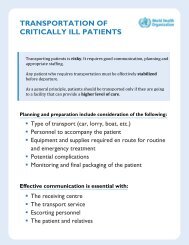SIGN meeting report 2003. - World Health Organization
SIGN meeting report 2003. - World Health Organization
SIGN meeting report 2003. - World Health Organization
You also want an ePaper? Increase the reach of your titles
YUMPU automatically turns print PDFs into web optimized ePapers that Google loves.
Recommendations<br />
prevention features (e.g., safety syringes) for general purposes. WHO is<br />
strengthening its collaboration with national regulatory authorities to ensure the<br />
quality and safety of injection devices through: (1) the enforcement of national<br />
regulations based upon international standards for injection devices and (2) reliance<br />
on internationally accepted certifying bodies that provide the ISO certification and<br />
carry out the auditing function. *<br />
5 The safe collection and disposal of used sharps (e.g., needles, syringes with fixed<br />
needles) are an integral part of the life cycle of injection devices. The collection of<br />
sharps waste in safety containers (e.g., safety boxes) at the point of use and their<br />
safe and environmentally-responsible disposal protect health care workers and the<br />
general public from needle-stick injuries. Interventions to reduce injection overuse<br />
reduce waste by facilitating its management. Management choice and technology<br />
options will depend on many considerations, including workers’ safety,<br />
sustainability and acceptability. Low-cost, effective waste treatment options are<br />
available.<br />
6 UNFPA, UNICEF and WHO have reaffirmed the current policy stating that by the<br />
end of the year 2003, all countries should be using only auto-disable syringes in<br />
immunization services. Auto-disable syringes and safety boxes should be supplied<br />
in adequate quantities with all consignments of vaccines.†<br />
WHO recommends that injection device security is ensured in all health care facilities,<br />
including therapeutic services (see box below), so that injectable medicines, diluents,<br />
single use injection devices and safety boxes are supplied in timely manner in adequate<br />
quantities. In practice:<br />
<br />
<br />
<br />
<br />
<br />
WHO reaffirms the need to ensure access to single use injection devices and safety<br />
boxes of good quality. Sterile, single use injection devices for injection and<br />
reconstitution and safety boxes must be available in every health care facility in<br />
sufficient quantities for the number of injections administered;<br />
While the use of sterilizable injection devices is being phased out worldwide, WHO<br />
urges that all countries use only single use injection devices for therapeutic<br />
injections. Syringes with a reuse prevention feature offer the highest level of safety<br />
for injection recipients. They should be considered for use for therapeutic injections<br />
where local data indicate that unsafe practices are particularly common;<br />
WHO urges that by 2005 all injectable medications are supplied with matching<br />
quantities of single use injection devices, appropriate diluents and safety boxes<br />
through essential medicine programmes and other health programme supply<br />
mechanisms;<br />
To prevent injection overuse, national drug policies should promote the rational use<br />
of therapeutic injections. This may include removing unnecessary injectable<br />
medicines from the national essential medicines list;<br />
<strong>Health</strong> care services must manage sharps waste as part of the duty of care in a safe<br />
and environmentally responsible way, within a broader policy of health care waste<br />
management. Awareness and training for appropriate sharps waste management is<br />
required. Sharps waste disposal management should be costed, budgeted, and<br />
funded.<br />
*<br />
ISO standard: ISO 7886 –1: Sterile hypodermic syringes for single use - Part 1: Syringes for manual use, 1993. www.iso.ch.<br />
†<br />
WHO-UNICEF-UNFPA Joint statement on the use of auto-disable syringes in immunization services. 1999.<br />
WHO/V&B/99.25.<br />
25


